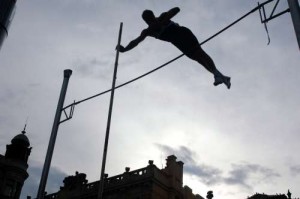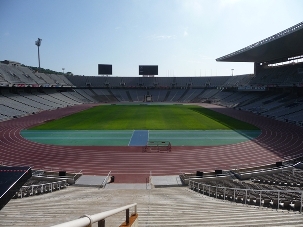August 2, 2010 | Posted by Shaun McCarthy
East London has a proud history of using waterways to provide prosperity and leisure and London 2012 is making a contribution to reviving this tradition. I joined British Waterways’ board recently in a review of the potential for the rivers and canals around the Olympic Park to contribute to the Games and a sustainable legacy. Various presentations took place during the day to start to illustrate the potential of this water city region. One of the most compelling was by Councillor Paul Brickell who neatly linked past and present by telling the audience that his great-grandfather had drowned in the Thames before setting out his perspective on the huge potential of the area for regeneration. The best stories however were from the rivers themselves. We travelled very slowly from Old Ford to Limehouse and very quickly from Limehouse to Canary Wharf. The trip from Old Ford gave a unique perspective to the Olympic Park, taking in the Forman and Field salmon smokery, a 100 year old business that was on the Olympic Park site, relocated just over the canal and now boasting an art gallery and swanky restaurant. They have purchased a plot of land next door to provide canal
…
July 27, 2010 | Posted by Shaun McCarthy
Siemens AG recently hosted a meeting of their main board and CEOs of all their global business divisions in London. The event was themed around urban sustainability and they invited a small group of movers and shakers on the London sustainability agenda to get involved. I was honoured to be part of that group. It seems to me that this global corporation totally understands the relationship between the success of their business, their relationship with stakeholders and the sustainable development agenda. However, the key to this success is their willingness to listen and properly engage with their client base. They have worked out that sustainable urban infrastructure has an important role to play for their business and they want to understand the context of sustainability for the world’s great cities, starting with London. They learned a lot, heard speeches from Boris Johnson (and Ken Livingstone), visited the Olympic Park and facilitated discussions with a very wide range of stakeholders, including the Carbon Trust, Forum for the Future and London focused organisations. All this will influence the objectives they set and the way in which they expect their supply chain to behave. There are eight people in Siemens’ management board and
…
June 8, 2010 | Posted by Shaun McCarthy
Tags: carbon, ODA, renewable energy
Gone when the morning comes… Like a bat out of hell it was gone when the morning comes. On 3 June 2010, the ODA announced the cancellation of their proposed wind turbine for the Olympic Park. With it came a little media storm with headlines such as “what hope now for the Green Games?” and “Olympic chiefs scrap wind power plan”. The first question I was asked by one journalist was “What other environmental targets are the ODA going to ditch?” Words like “scrap”, “ditch” and “abandon” appeared in most headlines. The fact is, the ODA are ditching nothing and
…
May 25, 2010 | Posted by Shaun McCarthy
May 2010 will see the publication of the Commission’s 2009/10 Annual Review. We are feeling increasingly optimistic about the delivery of sustainable venues by the ODA and we are impressed by the plans being developed by LOCOG to deliver a sustainable Games. We were less impressed with LOCOG’s management systems and we expect these to be improved in the coming months, but in general things are going well. Or are they….? If London 2012 had just promised to deliver sustainable venues and Games we could publish a very positive report. But much more was promised in the bid and in
…
May 10, 2010 | Posted by Shaun McCarthy
I was a child when England won the football World Cup in 1966 but I remember it vividly. I could still name the entire team and remember the drama unfolding at Wembley Stadium: the dodgy Russian linesman giving us the goal that never was, the extra time, Geoff Hurst’s hat-trick and the immortal commentary line “They think it’s all over…it is now!” These were more innocent times and the kids in our neighbourhood celebrated by charging round the street on our bikes singing the praises of “World Cup Willie”. Willie was the mascot for the 1966 World Cup, as I recall, a proud looking little cuddly lion wearing a union jack vest. Forty-four years later, another World Cup is upon us in South Africa and mascots are now part of the event. Some could argue they are something that nobody needs, manufactured for no purpose other than profit for the organisers. For others, it is an essential part of the experience and a lasting memory of the event. I wonder how many of today’s eight year olds will remember the 2010 mascot when they are in their fifties? The mascot for the World Cup in South Africa came under severe
…
April 5, 2010 | Posted by Shaun McCarthy
Tags: waste
The Commission’s recent waste review highlighted some great practice but I can’t help feeling disappointed. Good practice is transitory and of little benefit if it does not inspire change. The ODA have performed in exemplary manner: 97% waste diverted from landfill during demolition and 90%+ during construction. The second edition of the London 2012 Sustainability Plan introduced a new target to use “reasonable endeavours” to achieve 90%+ reuse or recycling after the Games. This is a remarkable target for the event management industry, which is usually very wasteful, particularly after an event, the period known as “bump-out” by the industry
…
March 1, 2010 | Posted by Shaun McCarthy
It could be said that the Corinthian Spirit sold her soul many years ago, that amateur elite sport has not existed for 30 years or more and that the Olympics these days are all about big money and sponsorship. How can the Games be sustainable if it is all about money? The structure of London 2012 reinforces this. The organisation responsible for investment in facilities is a public body (ODA) and funded with public money, whereas the organisation responsible for staging the Games (LOCOG) is a government-owned private company required to raise from private sources all of the £2 billion needed to stage the Games; mostly television rights, ticket sales, sponsorship and licensing merchandise. Everything is for sale. Companies are invited to pay cash, provide services for free, or both, in return for various levels of brand recognition to a global TV audience. Doubters question how such a hard-headed commercial environment could possibly deliver sustainable outcomes. Our most recent report on LOCOG’s procurement and commercial partnerships demonstrates that they are doing rather well. This starts to demonstrate that naked capitalism and sustainability are not mutually exclusive, and that profitable and sustainable solutions are there to be had for smart companies.
…
December 11, 2009 | Posted by Shaun McCarthy
There has been much said and written about food related to the Olympics. During my visit to Beijing, I wrote a blog for this website criticising the food offering at the 2008 Games and I was quoted in Building Magazine this year from a presentation at a conference, describing the food as “crap”. This was accurately reported by Building who also chose to ignore everything else that was said during my 45 minute presentation; good to see the media have a grip on the important issues! During the Games, approximately 14 million meals will be served. The huge challenge to prepare and serve food on this scale is daunting. The challenge to make that food offer safe, healthy, sustainable and affordable is a mountain to climb. LOCOG are in the process of developing their food vision and strategy and the Commission are currently conducting our independent food review, the results of which will appear on this website in early 2010. One area that tends to be forgotten is that London 2012 is also Europe’s largest construction project. The workforce of the three major Stratford-based construction projects (Olympic Park, Olympic Village, and Stratford City) is expected to peak at around 16,000
…
October 31, 2009 | Posted by Shaun McCarthy
It is 31st October 2009, and exactly 1,000 days to the opening ceremony for London 2012 and time to pause for reflection. After 3 years of the Commission, numerous reports, articles, meetings, discussions and not insignificant battles, exactly what do I expect it to be like in 1,000 days time? I expect viewers on TV to see things differently. The iconic Olympic flame will come from a more renewable fuel if they are successful. As the aerial cameras pick up the north side of the park, I hope they will pick up a 2 megawatt wind turbine. I expect the opening ceremony to feature sustainability without making us all feel guilty about having a good time. I expect to see pictures of volunteers and staff of all ages, all abilities and all colours and ethnic backgrounds. I expect visitors to feel different. When they arrive at any Olympic venue (not just the Park), the place needs to “feel” sustainable. This may be from the green space they enter, the sustainable features they see such as local renewable energy, the information they receive about things like segregating their waste, or the welcome they receive from East London’s diverse and multi-cultural local
…
October 15, 2009 | Posted by Shaun McCarthy
Barcelona hosted the 1992 Olympics and is generally held to be the prime example of using the Games to create a lasting legacy for the city. I was fortunate to take a short holiday there recently so I was able to check it out. The Olympic Park was constructed in the Montjuic area of the city, a big hill on the west side comprising mostly parkland and formal gardens. The area has a grisly history, having been the Jewish quarter of the city and site of Franco’s concentration camps after the Spanish Civil War. The main Olympic stadium was constructed
…



